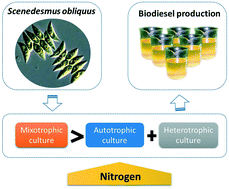FAMEs production from Scenedesmus obliquus in autotrophic, heterotrophic and mixotrophic cultures under different nitrogen conditions
Abstract
This study investigated the growth and biodiesel production of S. obliquus from autotrophic, heterotrophic and mixotrophic cultures under different nitrogen conditions. FAME productivities in the mixotrophic culture were 2.28 and 1.53 times greater than the combination of the autotrophic and heterotrophic cultures under nitrogen-replete and nitrogen-deplete conditions, respectively, which indicates that the mixotrophic process is not a simple combination of autotrophic and heterotrophic processes. Moreover, mixotrophic cultivation of S. obliquus coupled with nitrogen starvation led to the highest FAME productivity, which reached as high as 110.6 mg L−1 d−1. Furthermore, high fatty acid yield in the mixotrophic culture without nitrogen supply indicated that mixotrophic S. obliquus converted the assimilated carbon to fatty acids more effectively. This study suggests a great potential to recover COD as fatty acids via S. obliquus, where biodiesel productivity and COD recovery can be significantly improved by combining nitrogen starvation with mixotrophic cultivation.



 Please wait while we load your content...
Please wait while we load your content...